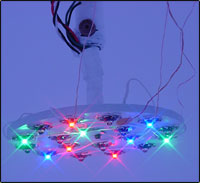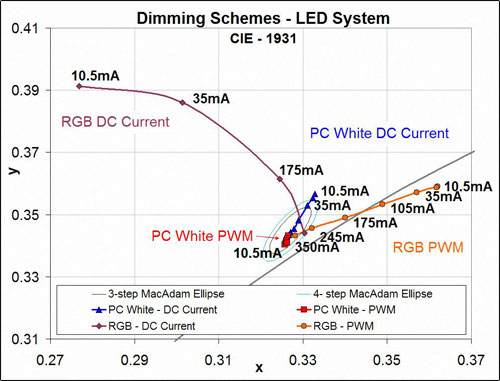

The RGB LED system used to evaluate chromaticity shifts under dimming conditions. |
Chromaticity Shifts in High-Power White LED Systems Due to Different Dimming Methods (2005)
In architectural lighting applications, dimming is an essential functional and aesthetic requirement of many types of spaces. The growing interest in white LEDs for general lighting has led to more flexible means of dimming control for these devices. However, maintaining a fairly constant white color while dimming LED systems is a challenge; in general, noticeable chromaticity shift during dimming is not desirable.
Two methods of dimming are available for mixed-color RGB (red, green & blue) and phosphor-converted high-power white LEDs: continuous current reduction and pulse-width-modulation (PWM). Continuous curent reduction involves a decrease in current supplied to the LED, which proportionally lowers the light output level. PWM involves rapid on-off cycling of the LED at a frequency high enough to eliminate any perception of flickering. However, little has been recorded showing the chromaticity shifts resulting from these methods. The objective of this study was to evaluate the chromaticity shift of high-power RGB and phosphor-converted white LEDs under these two dimming schemes.
EXPERIMENT
RGB and phosphor-converted (PC) white LEDs were mounted on a 6” diameter, ¼” thick round white-painted aluminum heat sink. The mounting positions of the LEDs were alternated such that no two similar colors were adjacent to one another. The mixed-color LED system consisted of three each red, green, and blue LEDs, and the PC white LED system of nine PC white LEDs. Each system was operated separately at several different dimming levels using the two dimming methods, continuous current reduction and PWM. Light output and spectral data were recorded for each LED system inside a six-foot diameter integrating sphere.
RESULTS
Figure 1 shows the results for each system at different dimming levels under each method. The white color point for each condition is plotted on a CIE 1931 chromaticity diagram. Overall, the chromaticity shift for the PC white LED system was less than that of the mixed-color RGB LED system. Additionally, each method caused the chromaticity to shift in different directions.

Fig. 1. Chromaticity shifts of phosphor-converted (PC) and RGB mixed-color LED systems under two types of dimming, continuous current reduction (DC) and pulse-width-modulation (PWM). |
CONCLUSIONS
Both dimming schemes provide small chromaticity shifts using the PC white LED system, with the PWM performing better than the continuous current dimming scheme. The RGB mixed-color system suffered large chromaticity shifts, regardless of the dimming scheme used. An active optical feedback scheme could be implemented for the mixed-color LED system to control and to confine the chromaticity shift within a 4-step MacAdam ellipse, the criterion for unnoticeable color variation.
TECHNICAL PAPER
Dyble, M., N. Narendran, A. Bierman, and T. Klein. 2005. Impact of dimming white LEDs: Chromaticity shifts due to different dimming methods. Fifth International Conference on Solid State Lighting, Proceedings of SPIE 5941: 291-299.
Full-text PDF
EQUIPMENT SPONSOR
Alliance for Solid-State Illumination Systems and Technologies (ASSIST)
Lighting Research Center
|


